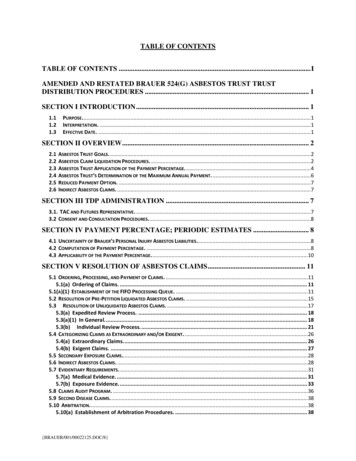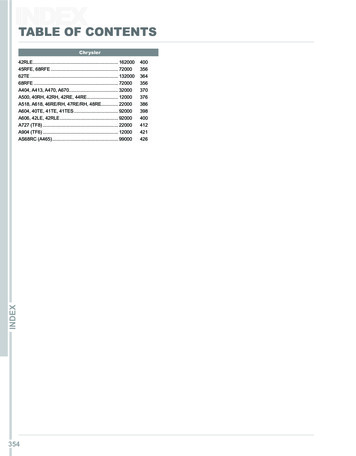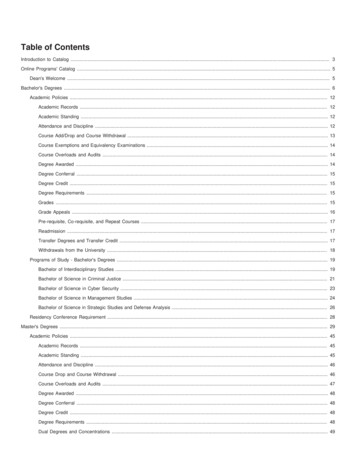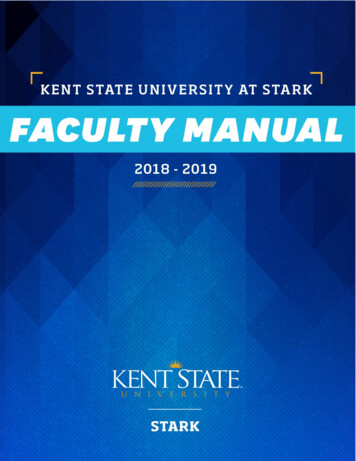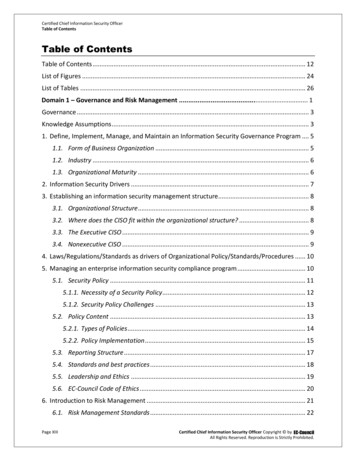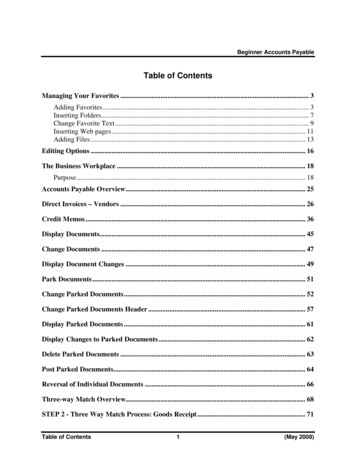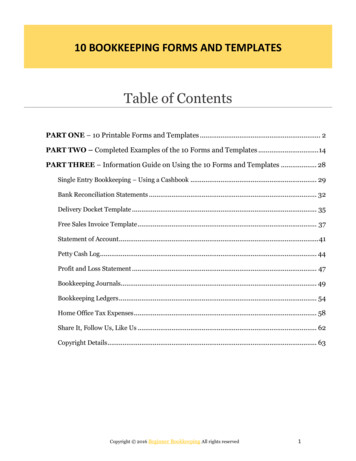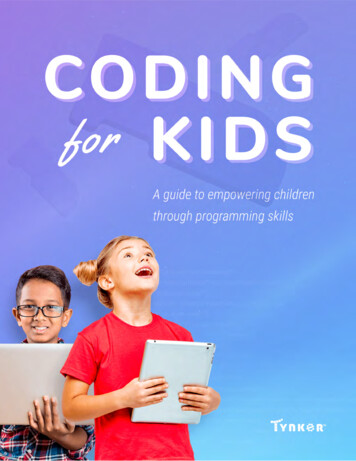
Transcription
Table of ContentsIntro to Coding3What Is Coding?3What Can My Child Do With Code?4Why Should My Child Learn to Code?5Coding Improves Your Child’s Academic Performance5Coding Develops Important Life Skills6Coding Prepares Your Child for the Future7Why Tynker?8Interest-Driven Learning8Game-Based Learning Experiences9Seamless Advancement to Text Coding10Tynker’s Global Community11Getting Started12Join Tynker for Free12Enroll in a Premium Plan12Taking A Deeper Dive13Begin Coding at Home14Learn How Coding Helps Kids Grow24Add Coding to Your School’s Curriculum442
Intro to CodingWhat Is Coding?There’s been a lot of discussion around coding lately, but it can be hard to figureout exactly what it means to code and how it plays a role in your child’s future.Coding (or computer programming), is the process of providing instructions to acomputer so it performs a specific task. You may have heard of popular textlanguages like Java, Python, or Ruby, but even kids can easily learn to code using avisual block language like Tynker!Why is coding so important? Believe it or not, we rely on code in the technology weuse every day – our mobile phones, thermostats, televisions, cars, and even thedevice you’re using to read this wouldn’t exist without code.3
What Can My Child Do With Code?In addition to the many practical and innovative uses for code in today’s world, it isalso a creative medium. With a coding education, your child can use their new skillsto create almost anything they imagine!Make Apps & GamesCreate AnimationsMod MinecraftControl LEGO Fly DronesExplore STEM4
Why Should My Child Learn to Code?When it comes to preparing your child for the future, there are few better ways todo so than to help them learn to code. Coding can help your child developacademic skills applicable to any grade level, in addition to building critical life skillslike organization, perseverance, and problem solving.Coding Improves Your Child’sAcademic PerformanceIt’s been proven that learning to codereinforces math skills, helping kidsvisualize abstract concepts and applymath to real-world situations. It alsoteaches logical communication,strengthening both verbal andwritten skills.Learning to code means learning a new language!Coding instills qualities like creativity that help kids perform better in school. Whenthey code, kids learn through experimentation and strengthen their brains, allowingthem to find creative solutions to problems.5
Coding Develops Important Life SkillsCoding is a basic literacy in the digital age. It’s important for your child tounderstand and be able to innovate with the technology around them. As your childwrites more complicated code, they’ll naturally develop life skills like focus andorganization. It also develops resilience – when kids code, they learn that it’s ok tofail and improve. There’s no better way to build perseverance than working throughchallenges like debugging code!Kids also feel empowered to make a difference when they code – many kids inTynker’s global community use the platform to spread messages of tolerance andkindness. Parents have even reported that their kids develop more confidence asthey learn to problem-solve through coding.6
Coding Prepares Your Child for the FutureIn today’s rapidly evolving digital world, it’s more important than ever that yourchild has the skills they need to adapt and succeed – and coding is a big part of that.Jobs are quickly becoming automated, and half of today’s highest-paying jobsrequire some sort of coding knowledge. By 2020, there will be 1.4 million computerscience–related jobs but only 400,000 computer science graduates to fill them,according to the Bureau of Labor Statistics.At the very least, kids today must be familiar with basic coding concepts in order toprepare for the job market’s demands. And like learning a second language,learning code is best done at a young age. 98,260Median salary ofa Software Developer“ I think basically every job in the future is going tohave to require some part of coding!”– Scout, Student in Australia7
Why Tynker?Our award-winning creative computing platform helps kids develop computationalthinking and programming skills in a fun, intuitive, and imaginative way. As they’reguided through interactive game-based courses, kids quickly learn fundamentalprogramming concepts. With Tynker, your child can apply their coding skills as theybuild games, tell stories, mod Minecraft, create apps, control drones and robots,and more! We even offer a parent dashboard where you can follow your child’ssuccess and share their creations.Interest-Driven LearningTynker’s scaffolded curriculum is organized around interest-driven learning. It’s asimple philosophy that means kids who already love to play with LEGO orBarbie will be more inclined (and genuinely excited) by the chance to integrateTynker with those interests, expanding their potential to play as they learn.Kids begin to code using Tynker’s block-based visual language, which helps themrecognize patterns and master programming concepts like sequencing, loops,conditional logic, and algorithmic thinking.From there, they can flex their creativity by animating their own games and tellingstories with code. Kids who’d like to dive deeper into concepts from the classroomwill enjoy creating projects with our STEM tutorials and puzzles. Our interactive8
notebooks make it fun for independent makers to learn JavaScript and Python attheir own pace.For more hands-on learners, our drone and robot programming courses are theperfect way to apply coding to the world around them. With the Tynker app, kidscan program their own mini-drone to fly patterns, perform flips and stunts, andeven transport objects. And with LEGO WeDo 2.0, kids can use programming tobring their LEGO creations to life!Game-Based Learning ExperiencesTynker’s self-guided courses are made up of individual lessons designed to create afun and captivating learning experience. Lessons build upon each other to ensureconcept mastery, and guidance from interactive tutorials empowers kids to learnindependently and at their own pace.As they learn, kids build mini-games, solve puzzles, create coding projects, completedaily missions, earn exciting badges, and unlock new characters. This is why kidslove learning with Tynker – even though they’re mastering important programmingconcepts, they feel like they’re just playing a game!9
Seamless Advancement to Text CodingTynker introduces kids to coding with simple visual blocks. This technique allowsyoung makers to learn the fundamentals of programming and create incredibleprojects without the frustrations of syntax. Whenever they’re ready, kids can startexperimenting in those same block-based activities by switching between visual andtext code blocks. Once kids become familiar with programming basics and syntax,they can move to full text programming with Swift, JavaScript, and Python.10
Tynker’s Global CommunityTynker’s award-winning platform is used by over 80,000 schools and 60 million kids,spanning more than 150 countries. Global partners include brands like Apple,Microsoft, Mattel, PBS, Sylvan Learning, and more.11
Getting StartedTynker’s game-based learning environment makes iteasy for your child to learn to code! Your child willbegin by using Tynker’s visual blocks to learnfundamental programming concepts throughself-guided game-based activities, then graduate totext coding languages like JavaScript, Python, and Swiftas they gain confidence in their new abilities.Join Tynker for FreeEnroll in a Premium PlanCreate a free Tynker account to giveyour child access to fun, free codingactivities. Access to our safe, andsecure tools is free, forever.Master skills five times faster withaward-winning courses and tutorials.Watch kids learn to code and buildamazing things. Get started with free coding puzzlesCode simple projects using tutorialsCreate Minecraft skins and modsSafe Secure 1,500 fun learning activities18 online courses10 iPad coursesPrivate Minecraft serverStudent progress trackingAffordable & flexible plans12
Taking a Deeper DiveTips for Encouraging Coding at Home14Make Screen Time Productive15Explore Tynker’s Maker Community18Get Inspired by These Kid Coders21How Coding Helps Kids Improve in Other Subjects24Improve Writing Abilities25Strengthen Math Performance28Develop Creativit y3 4Build Focus and Organization37Start Early: Girls Who “Make” Choose STEM37Invest in Your Child’s Future4 1Add Coding to Your School’s Curriculum44Try an Hour of Code45Build a Makerspace for Hands-On Learning46Hear from a Tynker Educator: Why Our CS Programs Are Working4713
Begin Coding at HomeThe best way to help your child learn to code is to treat it like any otherextracurricular activity – make a habit out of it! Building a habit can take a little time,but once your child integrates coding into their daily schedule, you will see theirlearning accelerate and their engagement skyrocket.Check out the following articles for ways to make screen time more productive,discover some fun (and free!) coding activities that you can do at home with yourchild, and get inspired by other makers in Tynker’s global community.14
Make Screen Time ProductiveIf you’re concerned about the amount of screen time your kids are engaging in,you’re not alone. Millions of parents worry that kids spend too much of their livesglued to screens, and for good reason – according to the BBC, the average childspends over 6 hours each day looking at a screen.But we’ll let you in on a little secret: you can give in to your child’s request forscreen time by leveraging that time with uplifting, engaging, and creative activities!It’s a trend on the rise, and it’s easier than you might think.Blend Learning and FunLeveraging screen time doesn’t mean allowing your children to play only strictlyeducational games. They don’t need to be drilling math facts or learning history –the key is to find ways to keep them thinking and creating. Let them discover thatlearning is fun!15
Try swapping simple, distracting games for tablet art apps, games that involvesolving mysteries or puzzles, and coding! Encourage your kids to find inspiration inthe world around them as they make art on their tablets. When your kids look for agame to play, help them find a game that uses problem-solving skills.“He actually gets to use the skills that I like to see him work on, like sharing artistic talent,music, art, as well as math.” – Lauren, Featured Maker Noah‘s motherTry having your kids program connected toys like drones or robots. They’re hugelypopular for good reason – kids get to use screens to create, then see the physicaleffects of their hard work and creativity in real-time. It’s entertaining, of course, butit also provides a great feedback loop!Distinguish Between Playing and MakingWe all love a little bit of mindless screen time now and then – social media is to youas gaming is to kids – but kids have an immense capability to learn and create thatneeds to be explored. Creativity is one of the most important skills your childrencan develop – in fact, a recent Forbes article cites creativity as the most importantskill for a future of AI!A good rule of thumb for leveraging your child’s screen time is to find ways to focuson “making” rather than simply “playing.” When kids are playing, they’re followingpredetermined paths. When they’re making, kids pave those paths.Here’s an example: your child is playing a game, clicking and dragging, following apredetermined path. She’s enjoying herself and relaxing, but she’s not as engagedas she could or should be.When she switches to building her own game, she’s interacting with the platform ina new way. She’s entertained by the prospect of a challenge, and pushes herself tolearn new things in order to figure out how to create what she wants to make.“My husband especially is very anti-screen time, so he doesn’t like the kids just watchingTV – but this kind of activity is something [Max] can do where he’s actually beingproductive. There’s a difference between passively just absorbing something and thenactively engaging with it.” – Stephanie, Featured Maker Max‘s mother16
Look to the FutureBy creating opportunities for your kids to learn during their screen time, you’rehelping them build good habits. As they begin to discover the magic of making, kidsmight even take their making skills offline with art, LEGOs, or backyard forts!Quell your screen time concerns by leveraging that time for learning. Kids thrivewhen they’re challenged and they love to create – what better way to encourageboth?“We don’t do electronics, we don’t do video games, we don’t do any of that stuff – but Icould see the benefit from Tynker. I thought “Wow, this is really cool,” so I let them do it.”– Priscilla, Featured Maker Isaiah‘s mother17
Explore Tynker’s Maker CommunityWhat happens when more than 60 million kids share coding projects with oneanother in a supportive and collaborative space? A whole lot of fun – and loads ofteaching, sharing, and supporting!When asked about their favorite Tynker feature, kids list things like the ease ofcoding with blocks, the ability to draw, and – almost unanimously – the Tynkercommunity!We are so excited by the way the Tynker community has taken off. We provide theframework and support for the community, but all the trends, ideas, and teachinghappening in the community is self-perpetuated. It’s constantly changing andimproving, but one thing stays constant: it’s always inspiring!“I like how when you look at the Tynker community there are so many projects that areall so different, but they’re all made with the same software. You look at the code andthere’s just so many opportunities for what you can make – it’s proof that everyone cancome up with a different thing. From the same building blocks, you can make all theideas that you have!” – Featured Maker Scout18
They Teach Each OtherNot only does the Tynker community motivate and inspire kids to code, but it alsohelps them learn! When we ask kids how they learned to use Tynker, they often citethe Tynker community. Kids look at the code in community projects in order tolearn how to code elements of their own games or projects in Tynker. We’ve evennoticed kids making “How to Use Tynker” tutorials as projects in Tynker!“I’m trying to figure make a joystick instead of the button system that I have,” Mark said,“but I haven’t figured out how to do that yet. I’ve been looking at other projects to try tofigure out how to do it.” – Featured Maker MarkThey Share IdeasUsing Tynker’s tools, kids have embraced the ability to truly create anything in theirimagination! Kids use Tynker to share what’s on their mind, teach others skills (likehow to draw a turtle!) make games to share, and even create educational mathactivities.“It’s not just coding, but it’s also giving them an opportunity to learn other topics, andshare what they know about other topics, which I thought was fantastic.” – Guru,Featured Maker Yaamini’s fatherIt’s inspiring to see that when given freedom to make whatever they want, manykids opt to educate about the environment or spread messages of respect. A fewmonths ago, one maker started a trend around projects about respect andencouraging others to be more kind. Other kids caught on quickly!They Support Each OtherAfter kids’ submitted projects are approved and published, they garner likes andviews from other users. The praise kids get from their peers is exciting andvalidating!19
“When she posted her first coded game, she was amazed by the number of views shegarnered within a few days and over a week. She couldn’t believe that her game was thatpopular, and the view of her first game encouraged her to continue coding othergames.” – Tynker ParentA love for coding (and a common understanding of its difficulties) bonds thecommunity together! They’ve all experienced the satisfaction of solving acomplicated problem and the frustrations along the way.“Almost everyone on Tyner has made their own program, so I think that people kind ofappreciate everyone else’s hard work more.” – Tynker UserA supportive community is an asset to kids learning to code. The ability to see whatother young makers are up to, give and receive positive feedback, and share theirmessage is important; it’s a way for kids to teach and learn concepts like kindnessas well as skills like animation (or how to make a pancake!).20
Get Inspired by These Kid CodersHailing from all around the world, our Featured Makers begin their coding journeysin many different ways! They discover us through enthusiastic teachers, supportiveparents, or all on their own; we discover them as we approve each project for theTynker community. Each week we share the profile of a child whose projects we’reespecially impressed by. Some create projects that are artistically stunning andothers write complex code – and all of the makers we feature inspire us with theirhard work and dedication. Will your child be next?Our Featured Makers all have big dreams and the determination to achieve them –catch a glimpse of some incredible kids who are coding up a storm!Kindness Advocate: Layla, 6th grade, CaliforniaKids spread kindness in the Tynker community; one of thefirst to code projects about kindness and respect wasten-year-old Layla. She was inspired at school and choseTynker as the platform to spread her message. She told us,“My school had a program about being leaders, so I wantedother people to be leaders and show respect to others. Istarted posting projects about respect and other people did ittoo.” Not only does Layla create projects advocating for a better world, but shecodes projects full of tips for fellow Tynkerers!Future CS PhD: Aidan, 5th grade, South CarolinaTenacity and passion are great characteristics foryoung coders, and it turns out eleven-year-old Aidanis chock-full of both! During our interview, he showedus a huge LEGO project he’s working on and said,“This one has 2793 pieces. I was building it all ofyesterday, and I only got two-thirds of the way done.21
I was working all day since I woke up!” Aidan has big dreams – he plans on a PhD inCS! In his words, “I want to do something to do with Computer Science. Thanks toTynker, I have a head start!”Creative Storyteller: Grace, 3rd grade, ScotlandWhen Grace grows up, she’d like to become either a doctoror a coder! In the meantime, she’s practicing by creatingamazing stories on Tynker. “I like to code because it’s reallyfun to make your own game and decide what will happen init,” she says. “I like when other people like my projects. Itinspires me if someone has a better game than me because itmeans I can look at it and see what they’ve done and if I cando anything different with my game.” We’re so excited thatGrace has found support for her passions in the Tynker community!Strong Girl in STEM: Scout, 8th grade, AustraliaEvery girl deserves to feel welcome and included inthe STEM world, and fourteen-year-old Scout ishelping to craft a future in which women in STEM isthe norm. Scout is involved in a club supportingcoding for girls in her community, has taught herselfPython, and has a deep understanding of the importance of learning coding.According to her, “I definitely think that lots of people should try to get involved –it’s so important! At my school, there’s not much coding, so people should try totake advantage of all the opportunities that are given.”22
Budding Game Designer: Anthony, 5th grade, IllinoisEvery Tynker user has their own reason to code and can relatecoding to their dreams for their futures, whether those dreamsinclude CS or not. For Anthony, Computer Science gives him thetools to follow his passion – gaming! He aspires to open amassive gaming center his father used to own, and even wantsto design games himself. According to Anthony, “I think every kidin the world should code! It’s so fun, and it gets your brainthinking. Why not have no school and just code all day? Same thing, right? It getsyour brain thinking!”When you give your children and students a bit of inspiration and access to toolsthat teach, you provide them with a world of possibilities. How will the kids in yourlife use Tynker to express creativity and follow their dreams? We can’t wait to seewhat they come up with!23
Learn How Coding Helps Kids GrowYou’ve already read a little bit about how your child benefits from learning to code –you know that it can improve your child’s academic performance, developimportant life skills, and prepare your child for the future.Read through this next section for a deeper look at the ways coding helps yourchild as they learn and grow. We cover how coding helps kids write better, earnbetter math grades, develop creativity, and improve focus and organization. You’llalso learn why now is the time for your child to begin programming, how computerscience prepares your child for the future, and why girls who create with code excelin STEM fields. There are so many reasons to help your child learn to code!24
Improve Writing AbilitiesDeveloping strong writing skills – especially when paired with technical abilities likecoding – all but guarantees your child success in school and beyond. But did youknow that writing and coding actually go hand in hand? When they learn to codeand create digital storytelling projects, children acquire skills that improve theirwriting, and they have fun in the process.Coding is a New Medium for Imaginative StorytellingA writer’s tools for telling a story include words and sentences. Coders have accessto a more open-ended medium, including pictures, music, and animation inaddition to words. The flexibility of programming even allows children to make theirstory react to audience input.25
“I really like creating stories, writing – so I thought if I could code it and make pictures,it’d be even better.” – Featured Tynker Maker GraceWriting a script in a story-based game forces kids to think through the exact detailsand consequences of how their characters act. They can’t be vague – they have tohone their ideas, an important skill that takes practice.“3rd graders created stories with dialogue and lively characters in Tynker. They were socaught up in creating and narrating their stories, they didn’t even realize they werecoding, writing, and crafting a compelling storyline at the same time.” – Kathy Bottaro,Digital Learning Program Coordinator, Sioux City Community School District, IowaCoding Reduces the “Blank Page” SyndromeCreating a story-based game requires narrative pacing, compelling storylines,engaging dialogue, and an understanding of the audience. In short, it requires thesame skills that some children struggle with when their English teacher hands out acreative writing assignment.The difference is that staring at a blank sheet of paper often evokes panic, butprogramming offers multiple starting points.When they code, kids start with one character, then experiment with dialogue,movement, and interactions. They build from there by adding other actors, scenes,and interactions. The program starts at the child’s point of interest and evolves to afinal product through a process of experimentation and iteration. When coding,there is no “blank page,” only discrete problems to be solved.Coding Teaches the Value of ConcisionWhen kids first start coding, it takes them five lines of code to program a characterto move across the screen. As they learn more programming concepts, like loopsand conditional statements, they can condense that code to two lines. Children26
learn that the goal of coding – or of writing – is to leverage the tools at theirdisposal in the most powerful way possible to express ideas efficiently and directly.These are the kids who will write a 650-word college application essay that getsthem noticed.Coding Teaches Planning and Organizing SkillsProgramming and writing follow a similar process. When children start a codingproject, they plan out the different functions they will need and how thesefunctions will work together to make the project work. Likewise, to write an essay,they must organize their ideas into paragraphs and understand how theparagraphs fit together.“Coding helps develop the organizational skills required for good writing. I encourage mystudents to plan their writing assignments by breaking down their topic, selecting theevidence they need, and sequencing their points in a compelling way. Some of the sameskills are required when planning a video game. The more rigorous they are as theydivide a large problem into components and organize tasks, the more successful theywill be.” – Lucinda Ray, Educator and Writing InstructorThe interactive nature of programming makes challenging subjects moreaccessible. Whether your child loves to write or needs a bit of help, coding is a funactivity that will supplement their Language Arts education.27
Strengthen Math PerformanceThe conventional belief has always been that kids interested in coding shoulddevelop strong math skills. However, it turns out the reverse may also be true:coding can help children build math skills and make learning math more engagingand fun.In the three years that Casita Center, a magnet elementary school in SouthernCalifornia, has been teaching coding with Tynker, they’ve seen considerableimprovements in their students’ math scores, outperforming virtually all Californiaschools with similar demographics. Jenny Chien, the school’s STEM specialist,believes this improvement is due to the effectiveness of their CS program. Whenkids learn to code, they develop key skills like problem solving and practicealgorithmic and computational thinking – and when they learn to code with Tynker,they have fun at the same time, so they’re more likely to stay engaged with thematerial. These broad skill sets and ways of breaking down and analyzing problemstranslate across the curriculum and are particularly helpful when it comes to math.Whether kids are learning to code at school or at home, you may just see an impacton their overall academic performance! Here are a few ways that coding helps kidslearn math:28
Coding helps kids visualize abstract conceptsGrasping abstract math concepts can be a challenge to many kids and put them offthe subject entirely. Parents, teachers, and technology specialists are using Tynkerto help children visualize abstract math concepts.“One of the most common cross curricular benefits of computer programming isthat the kids have an easier time learning math skills,” says Michelle Lagos, acomputer science teacher who uses Tynker in elementary classes at the AmericanSchool in Tegucigalpa, Honduras. “When they have to work on long division, it iseasier for them to visualize the numbers now instead of counting with their fingers.They visualize the equation and think of the best way to solve it.” Lagos reports thatshe has “seen kids in many grades improve their math skills” by using Tynker tolearn coding.Jesse Thorstad, Technology Coordinator for the Fergus Falls Public Schools districtin Minnesota, has had a similar experience. “Tynker provides kids with a concreteexample of the power of decimal places,” he says. “When studying decimals inmath, the students experience a heartwarming ‘Ah-ha!’ moment when they see howmoving a decimal block of code can affect the objects on the screen tenfold.”Kids explore the real-world applications of math conceptsRepairing spaceships or saving puppies with Tynker is a great way for a child to seeconcrete applications of math strategies. Tynker parent Sri Ramakrishnan pointsout that kids develop stronger math skills when applying concepts in a real-worldcontext: “The computational thinking involved in computer programming involveslogic, organizing and analyzing data, and breaking a problem into smaller and moremanageable parts. Much of this is also required when solving math problems!”29
Math can be used in creative coding projectsKids who use Tynker see how math is inherently creative – 10-year-old Jacob Myers,a big math buff who regularly competes in math contests, uses Tynker to makemath art with spirals and triangles! Kids can also complete activities like PatternMaker and Spin Draw to learn how to create art with coding and math.Coding teaches problem-solving skillsCoding is a real-world way to teach mathematical thinking. When students create ordebug a program, they practice solving problems. Math teachers find that Tynker’sbeginning lessons are a great way to teach pattern identification as well. Teacherscan assign activities like Multiplication Escape or Analog Clock and encouragestudents to find solutions with math.Coding makes math more fun“My kids ask to program with Tynker because they enjoy it,” says Jennifer Apy, theparent of a 15-year-old, an 11-year-old, and an 8-year-old. “Without realizing it, mykids are identifying attributes and grouping variables, applying conditional logic,developing algorithmic functions, and calculating angles within geometric shapes.But most of all, they are patiently articulating hypotheses to solve problems, andboldly applying trial-and-error experimentation, strategies required by any field ofstudy. And this is in addition to some of the coding that requires real math – tocorrectly calculate wait times, set score counters, calculate points, and timeinteractions between characters in their games.”“If kids realize they are using math when programming Tynker games,” Apy says, “itcould actually build their confidence with math and show them that mathematicalthinking can be cool.”Math is cool? What could be better than that?30
Develop CreativityCasey stares at his computer screen, carefully calculating his next move. As part ofa school science project to create a simulation of the Earth’s tides, he has spent thebetter part of the hour
begin by using Tynker’s visual blocks to learn fundamental programming concepts through self-guided game-based activities, then graduate to text coding languages like JavaScript, Python, and Swift as they gain confidence in their new abilities. Join Tynker for Free Create a free Tynker account to gi
